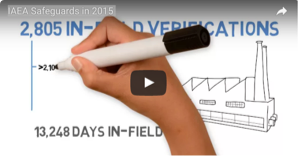Small Unmanned Autonomous Surface Vehicle (USV)
Inspectors frequently use a small handheld optical instrument called the Improved Cerenkov Viewing Device (ICVD) to confirm the presence of spent fuel stored underwater. The IAEA would like to mount this device inside a small robotized floating platform, which would autonomously propel itself across the surface of the pond, while stabilizing the ICVD in a vertical position.
View more detailsSmall Unmanned Autonomous Ground Vehicle (UGV)
Inspectors conduct a routine task that includes counting containers, recording their ID tags and performing gamma measurements. The IAEA would like to identify small robotized rolling platforms able to assist the inspector by moving autonomously across a storage area, counting items of a specific geometry, recording their ID tags, and carrying specific IAEA instrument payloads.
View more details
Participants looking for further details will need to register on IAEA’s Challenge platform in order to be provided with full description of these tasks as well as with the templates and submission forms to submit the proposal.
Prize and Incentives
Compete for a prize of 5,000 EUR plus and win a trip to Australia for two persons per proposal to join the Demonstration Week.


UGV 2nd Prize: 3,500 EUR


UGV 1st Prize: 5,000 EUR



Win 5,000 EUR and two seats to Australia
Participants with the best technical proposals will receive funding to participate in the Demonstration Week, organized in Australia (attendance limited to two individuals per proposal).
The IAEA will allocate 20,000 EUR to support private entities or small businesses and will eventually facilitate access to alternative sources of funding for other categories of organizations.
Submit your proposal
Roadmap
The Challenge includes the 5 stages outlined below. Participants evaluated technically acceptable will be invited to provide a commercial proposal so that some units can be acquired by the IAEA.
Start of the challenge
Participants need to register on IAEA’s Challenge platform, indicating their intent to participate in the challenge and providing their contact details. Registered participants will receive full access to the challenge page with technical details and to the proposal submission page with instructions and form templates.
Registered participants will also get access to the regularly upsade Question / Answer page and contact form allowing to send clarifying questions to the organizers.
Participants’ technical proposals
The technical proposal shall be in the English language. The technical proposal shall be precise and concise; catalogues, marketing or commercial documentation shall be avoided, unless necessary.
Participants shall provide the deliverables indicated as part of their proposal; the deliverables shall be uploaded via the submission page; reception will be acknowledged.
Any communications/requests for clarifications related to the technical proposal shall be addressed to d.finker@iaea.org with a copy to a.ivanov@iaea.org.
Technical Evaluation
A panel of inspectors and IAEA experts will evaluate the proposed technologies against the criteria outlined below. The evaluations will be updated at the end of each stage 2-4 in order to determine final technical acceptability:
• Applicability to fulfill key scenarios
• Compactness and ruggedness
• Ease of customization facilitating IAEA deployments
During the evaluation period, additional clarification questions may be sent by the IAEA to the participants.
Proof-of-concept
If the selected Proof of Concept requires any significant customization level of effort, the IAEA may be inclined to finance some of the associated development cost to be agreed between the Parties.
Procurement (Request for Proposal and Contracting)
The IAEA will invite Participants to submit commercial proposals in accordance with IAEA procurement policy. The commercial proposals will be evaluated based on the final technical scores at the end of Stage 4 Proof-of-Concept as well as commercial acceptability of the Financial Proposal and Contractual compliance.
A Blanket Purchase Agreement (BPA a.k.a. IQIQ, Indefinite Delivery/Indefinite Quantity) will be awarded to the Bidders who submit the best value for money combining “cost and quality”.
When applicable, selected participants shall transfer the software source-code to allow the IAEA to customize the solution on its own. The IAEA may award multiple Agreements related to this project.
About IAEA
The IAEA, or the International Atomic Energy Agency, is widely known as the world’s “Atoms for Peace” organization within the United Nations family. Set up in 1957 as the world’s centre for cooperation in the nuclear field, the IAEA works with its Member States and multiple partners worldwide to promote the safe, secure and peaceful use of nuclear technologies.
Year Founded
1957
Headquarters
Viena, Austria
Organization type
Government Agency
IAEA Technology Challenges
One of the roles of the International Atomic Energy Agency (IAEA) is to deter the proliferation of nuclear weapons. To do so, the IAEA applies various technical measures referred to as ‘safeguards’ to verify the correctness and the completeness of the declarations made by the Member States about their nuclear material and activities. The IAEA safeguards are an essential component of the international security system.
The Division of Technical and Scientific Services (SGTS) is responsible for providing scientific, technical and logistics support within the IAEA, including design, development, testing, calibration, installation and maintenance of safeguards equipment.
Within SGTS, essential objectives of the Technology Foresight activities are to identify and evaluate emerging technologies that improve the usability, effectiveness and efficiency of the instruments used in the field by inspectors, and to enhance the IAEA's capabilities to detect undeclared activities.
What are we doing
Conducting in-field inspections forms the core of the IAEA’s nuclear verification activities and equipping inspectors with the appropriate tools is the key to effective nuclear safeguards. Over hundred types of equipment are used by the IAEA inspectors to verify the form, isotopic composition and quantity of nuclear material.
IAEA Robotics Challenge
Submit your proposal to compete for a prize of 5,000 EUR and win a trip to Australia to join the Demonstration Week

